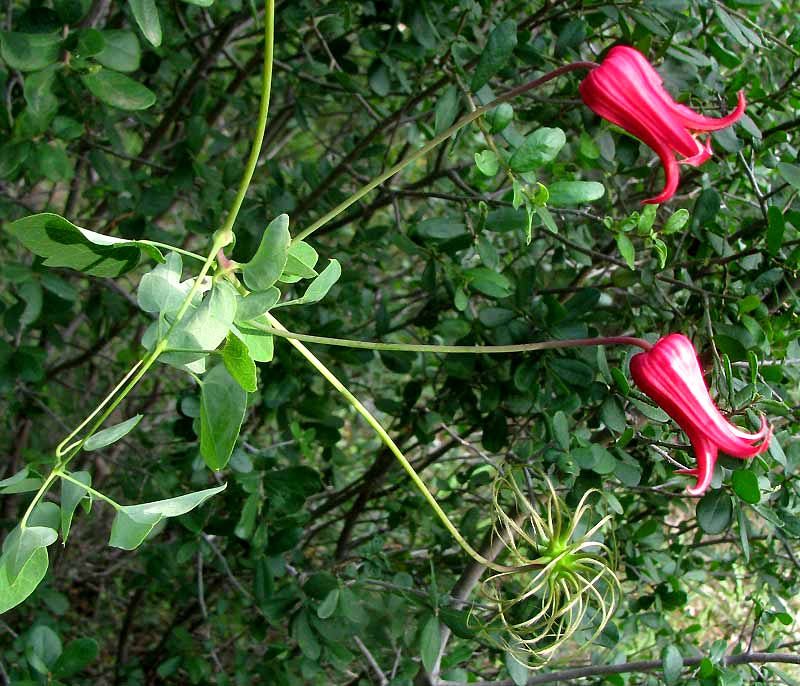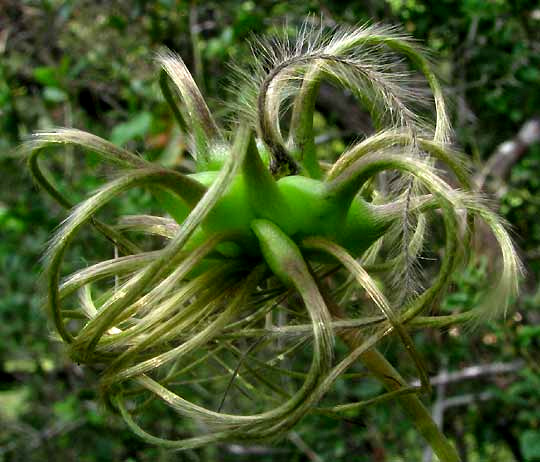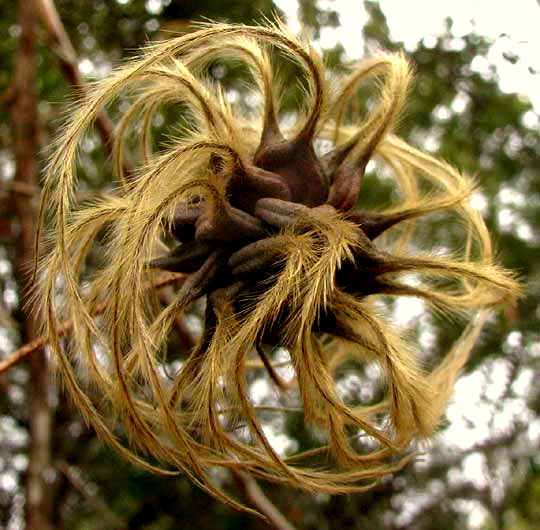Excerpts from Jim Conrad's
Naturalist Newsletter

from the July 14, 2013 Newsletter issued from the Frio Canyon Nature Education Center in the valley of the Dry Frio River in northern Uvalde County, southwestern Texas, on the southern border of the Edwards Plateau; elevation ~1750m (~5750 ft); N29.62°, W99.86°; USA
SCARLET CLEMATIS
I'm amazed at how many rare and uncommon species I'm finding here on the Edwards Plateau's southern slope. For example, I was biking along the entry road a few miles south of the Center when suddenly there appeared the spectacularly flowering vine shown above.
The urn-shaped flowers' corolla-like parts are leathery, and if you look closely you see that actually the blossoms have no corolla at all. The red parts are modified calyxes. Typically calyxes are green and inconspicuously subtending colorful corollas, so here we have calyxes doing corolla service by attracting pollinators with their vibrant red color.
The sea-urchin-like fruit cluster below the blossoms is familiar to any gardener who grows clematis vines. Below, you see a close-up of a fruit cluster showing the slender, very hairy, curved "beaks" of individual achene-type fruits:

A further field mark indicating that this is indeed a wild clematis is that of the compound leaves on their long, slender petioles, seen below:

So, this is a clematis vine, but which one is it of the 32 species described in the online Flora of North America?
It turns out that identifying our roadside vine was easy. It's CLEMATIS TEXENSIS, commonly known as the Scarlet or Texas Clematis. Here's how the Flora of North America characterizes the species: "Although widely cultivated because it is the only species of Clematis with truly red flowers, C. texensis is native only to the southeastern part of the Edwards Plateau, Texas."
The only Clematis with truly red flowers! And found in nature only here on the southern slope of the Edwards Plateau!
You might enjoy looking at a page showing cultivars developed from our The cultivars bear such evocative names as 'Duchess of Albany,' 'Etoile Rose' and 'Gravetye Beauty.' The page is at http://www.taylorsclematis.co.uk/Clematis-texensis/.
from the January 5, 2014 Newsletter issued from the Frio Canyon Nature Education Center in the valley of the Dry Frio River in northern Uvalde County, southwestern Texas, on the southern border of the Edwards Plateau; elevation ~1750m (~5750 ft); N29.62°, W99.86°; USA
SCARLET CLEMATIS FRUITING
Nowadays Scarlet Clematis vines bear brown, leathery leaves and fruit clusters that are nearly as attractive as the flowers, as shown below:

A close-up of the head appears below:

The head, which could be called an infructescence, is composed of numerous fruits, and the whole head has developed from a single flower. The flower had borne several pistils, however, and each pistil had formed a single achene-type fruit -- an achene being a dry fruit that doesn't split open when it's mature. Clematis achenes are topped with long, often curved necks called "beaks," and the beaks are very hairy, with divided hairs. Divided hairs are said to be "plumose," which means feathery. Plumose beaks help clematis fruits disseminate by wind.